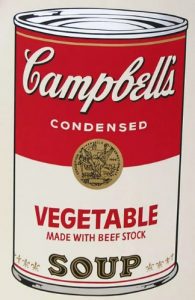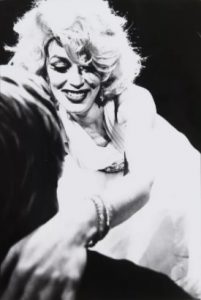
Andy Warhol, ‘Shot Sage Blue Marilyn’ 1964. © Christie’s Images Limited 2022. Courtesy of Christie’s.
We live in a time where the art market has moved past mere trophy hunting. For the mega-rich, buying a major work of art is no longer only about aesthetics or investment. Like the pharaohs of ancient Egypt, who built elaborate tombs as monuments to their immortality, the world’s wealthiest art buyers now desire eternal fame.
Without art, Eli Broad, who died last year, would have been just another ultra-successful businessman. But thanks to his astonishing trove of blue-chip art—now on view in his eponymous Los Angeles museum—he’s become a household name in the art world and secured a profile that will continue to live on.
In recent years, we’ve witnessed the sale of a $110 million Jean-Michel Basquiat to the Japanese businessman Yusaku Maezawa. Who had ever heard of him prior to his big auction score? Now, he’s internationally famous—at least in the art world. Upping the ante, Prince Mohammed bin Salman acquired the Salvator Mundi, allegedly by Leonardo da Vinci, for $450 million. You better believe his purchase calculus was informed by his desire to put Saudi Arabia on the map as a destination for high culture—and assure his own legacy.

Christie’s in New York, which is set to auction Warhol’s Shot Sage Blue Marilyn. © Christie’s Images Limited 2022. Courtesy of Christie’s.
Which brings us to Andy Warhol’s Shot Sage Blue Marilyn, set to be auctioned at Christie’s on May 9th and predicted to sell in the region of $200 million, which would make it the most expensive 20th-century artwork to ever sell at auction. During his long and storied career, Warhol produced an inordinate number of masterpieces, but even among these, certain projects stand out: the set of 32 Campbell’s Soup Cans (MoMA), Gold Marilyn (also at MoMA), and the five 40-by-40-inch Marilyn paintings made in 1964. All five are great. But arguably, Shot Sage Blue Marilyn is the best of them. Whoever buys it will join the elite club of those collectors who have already achieved immortality.
Warhol’s earliest Marilyn paintings rocketed his profile during his first show in New York, in 1962, at Eleanor Ward’s Stable Gallery. Even before that exhibition, Ivan Karp, the director of Leo Castelli Gallery, had been pleading with his boss to represent Warhol. But Castelli felt the work was too similar to that of Roy Lichtenstein, whom he already represented. Warhol was deeply disappointed by the rejection, desperately wanting to be part of the Castelli roster, which also included Jasper Johns, Robert Rauschenberg, and Frank Stella.
But if Warhol felt like he was settling for Stable Gallery (so named because its location was once a stable for police horses), his inaugural show there would dispel any notions that his vision was second-rate. The exhibition marked the debut of his series of small (20-by-16-inch) Marilyns. Most of their titles were derived from Lifesaver candy flavors. They were priced at $250 each. All of them sold. The landmark exhibition also included the magnificent Gold Marilyn, which was snapped up by the architect Philip Johnson, who proceeded to donate it to the Museum of Modern Art.

Andy Warhol ‘Campbell’s Soup I, Cream of Mushroom F&S II.53’, 1968; Fine Art Mia; US$89,000

Andy Warhol, ‘Campbell’s Soup I, II.48 Vegetable Made with Beef Stock’ 1968; Elizabeth Clement Fine Art; US$50,000
Karp and Castelli both attended the opening reception and walked away stunned by the power and beauty of the Marilyns. Castelli, who was probably as impressed by the strong sales as the paintings themselves, confessed to Karp that he had been wrong about Warhol. That mistake was soon rectified as Warhol was asked to join the Leo Castelli Gallery after his second Stable Gallery show—another historic display that featured his iconic Brillo Boxes.
It’s also interesting to note that the Marilyn paintings proved so popular that, in 1967, Warhol’s studio released a portfolio of 10 Marilyn prints. The set was originally priced at $500. Many of the sets were broken up so the prints could be sold individually. Today, you would be lucky to find a complete portfolio with matching numbers, in pristine condition, for $3.5 million. But these are, of course, multiples, and a far cry from the 1964 works.
As for that original group of five Marilyns, they went on to acquire a mystique all their own. In 1964, a performance artist named Dorothy Podber walked into Warhol’s Factory, saw four of the pieces leaning against the wall, and asked to “shoot” them (presumably with a camera). She then whipped out a pistol from her purse and shot a hole right between the eyes of the paintings. A stunned Warhol eventually had them restored—to various degrees—and the canvases became known as the “Shot Marilyns.” There’s no doubt this outrageous story added then and now to the value of these works. The irony was that only four years later, in 1968, the deranged groupie Valerie Solanas also pulled a gun from her purse. But this time, it was Warhol who was shot—and came perilously close to dying from the encounter.

Andy Warhol ‘Photograph of a Marilyn Monroe Drag Impersonator’ 1981; Hedges Projects; US$18,000

Andy Warhol ‘Any Warhol Self-Portrait’ ca. 1980; Heather James Fine Art; US$40,000
While the path the Marilyns took to the world was varied and hazy thanks in part to the cash-and-carry approach that was common at the Factory—Peter Brant bought one from Warhol for $5,000, the cost of a Cadillac at the time—their lineage becomes clearer as they’ve traded hands on the secondary market. And as they’ve steadily increased in value.
In 1989, the Los Angeles–based collector and computer magnet Max Palevsky sold Shot Red Marilyn at auction for $4 million to a Japanese collector named Masao Wanibuchi. Five years later, in the middle of an art market recession, he sold it at a loss for $3.6 million to Philip Niarchos.
In 1998, S.I. Newhouse acquired Orange Marilyn at auction for $17 million. I was in the crowd that night as I watched Larry Gagosian lift his pen to bid on Newhouse’s behalf. A few days after the sale, I had a conversation with Fred Kraushar, son of the great Pop art collector Leon Kraushar, who was the original owner of Orange Marilyn. When I informed Fred of the results, there was a pause on the phone. Then Fred said, “I grew up with that painting—it was in my parents’ bedroom. But now I just want to go stick my head in the oven!”

Andy Warhol ‘Leo Castelli’ 1971; Heather James Fine Art; US$15,000

Steve Schapiro ‘Andy Warhol, Castelli Gallery, New York (Contact Sheet)’ 1965; Fahey/Klein Gallery
Fast-forwarding to 2007, the Chicago-based collector Stefan Edlis sold his wonderful Turquoise Marilyn (the only painting to escape the shooting) to the hedge fund king Steven Cohen, for an alleged $80 million. Finally, in 2018, upon the death of Newhouse, former Sotheby’s auctioneer Tobias Meyer was enlisted by the Newhouse family to privately arrange the sale of Orange Marilyn. He sold it to hedge fund titan Kenneth Griffin for $200 million (the number $250 million has also been tossed around).
We assume that $200 million figure was used by Christie’s to set a presale estimate for Shot Sage Blue Marilyn. There’s some talk that it may exceed the Salvator Mundi in price and could bring $500 million—which would make it the most expensive painting ever sold. Regardless, whatever it sells for, the buyer will achieve more than the clichéd “15 minutes of fame”—he will achieve immortality.
Richard Polsky
On 9 May, ‘Shot Sage Blue Marilyn’ made history when it sold for $195 million during Christie’s 20th and 21st Century marquee auctions — making it the most expensive 20th century work of art to sell at auction.
Source: Artsy







